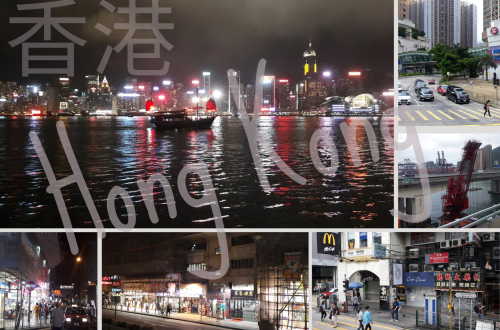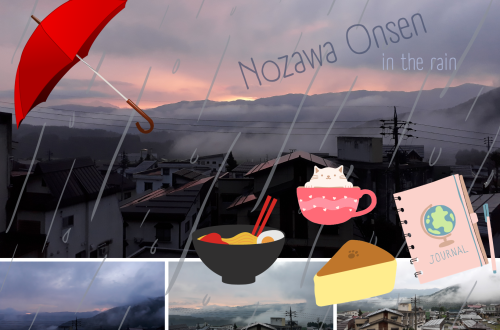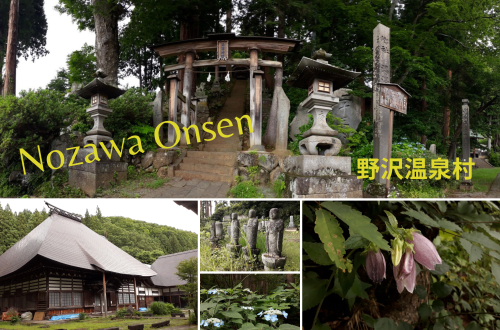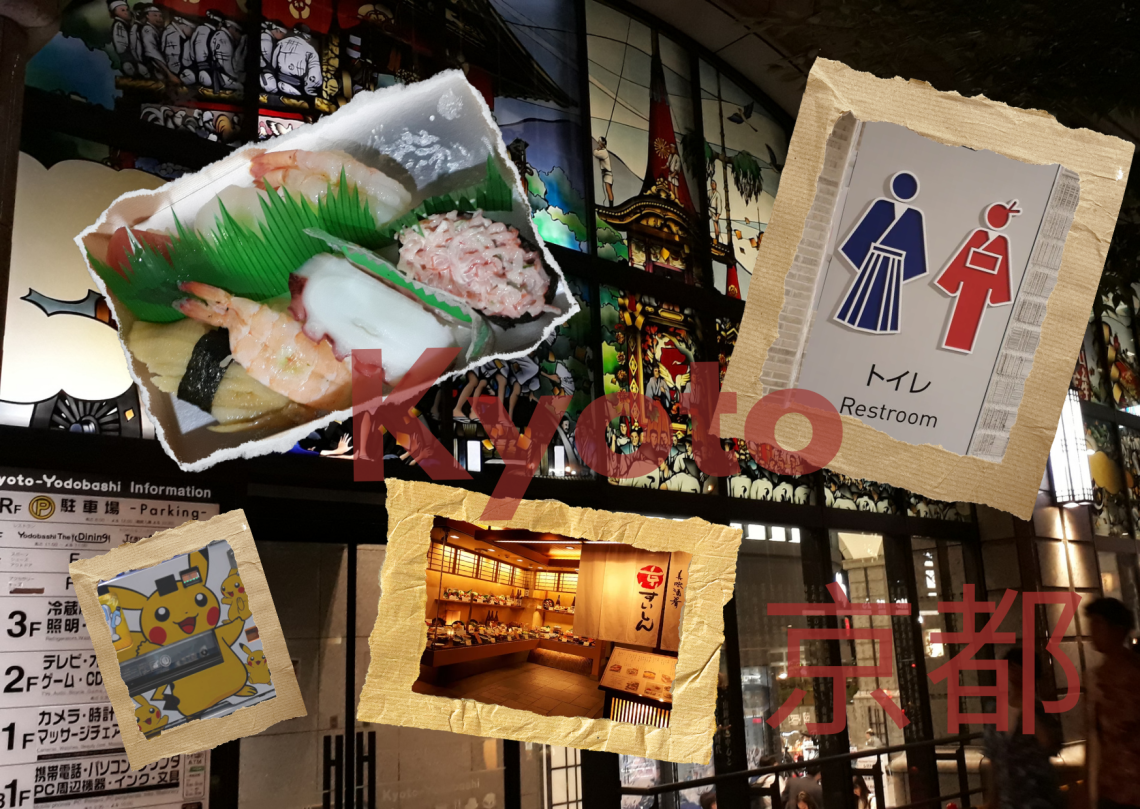
Treeleaf Diary entry 3.1: Kyoto, Japan
Konnichiwa, Japan! First experiences at Kyoto Station
Original post from July 6, 2019 (edited and updated on October 29, 2022)
Before getting to Japan, to ensure the following chapters make more practical sense, I should probably talk a little bit about Workaway. That is, about the volunteers program that allowed me to spend a lot more time in some countries than a backpacker's budget would otherwise enable. Plan to do voluntary work was there in my mind already before starting my journey - I saw that as a great way to do something I've never done before, regardless of previous experience. It also seemed as a perfect opportunity to learn more about local life and people - through locals.
Therefore, Workaway (there are others like it, it's just one I chose) is an international online platform that is created to bring together those who want to do voluntary work, and those who need help with all sorts of projects and jobs, for which the payment is not money but food and accommodation. There are plenty of those who need help seasonally or with a certain project, but is not able to directly hire someone (or doesn't want to). And there are also a lot of those who wish to more closely experience the local life of a foreign country and learn something new but consider paid volunteer programs too expensive (which they often are). Of course, using Workaway is not completely free but for about 30 dollars (in 2019 at least) you got access to at least 90+ projects in any country. Just choose the one you want and apply! During the time I used it, the most popular (non-specific) works on offer were working in a hostel but there was also a lot of farm and field work. For more specific skills there were quite a few more creative options as well.
It was precisely with the help of Workaway projects that I planned to go to Japan. It's no secret that living in Japan is rather expensive, so I saw voluntary work as the best (and only) option to spend more than a couple of days or weeks in Japan.
I found a suitable project in the Prefecture of Nagano, in a small town called Nozawa, or Nozawa Onsen. In 1998 it was one of the locations for the Winter Olympics where competitions were held (Nordic combined I think as well, if I remember correctly). It is a ski village - almost the whole "village" (officially a small town, but I'm used to calling it a village) is surrounded by moutains whose otherwise forest-covered hillsides are "shaved" in multiple places to accommodate ski and snowboard slopes. Resort town - in the winter. As I'm not much of a ski or winter sports fan myself, I went there in the summer instead. A villa-guesthouse that also deals in ski and snowboard rent was looking for help with summer maintenance works - weeding, mowing the grass, cleaning of the general spaces of the guesthouse and sometimes housekeeping after guests. Easy!
Up to the moment I actually received the "yes" from the owners of that project after my application, I had no other plans for Japan other than a plane ticket to Osaka - you weren't even able to enter the United States without a return or forward ticket. This was the case (in 2019, no idea how things are now) with many countries in Asia, and especially in Japan and Taiwan it was checked rather meticulously.
So, I had a ticket to Osaka which is located more to the south of the main larger islands of Japan, on an island called Honshū - the biggest one in Japan. But I needed to get to Nagano. I had previously read that the most affordable way to travel in Japan was a night bus - departing at night and you'll be at your destination in the morning! With good luck it's even possible to get some sleep on the bus.
Night bus and that I needed to get from Osaka to Nagano, and from there to Nozawa (for this I had specific instructions) was more or less everything I knew when I stepped onto the plane. I was going to just figure everything out as I went along!
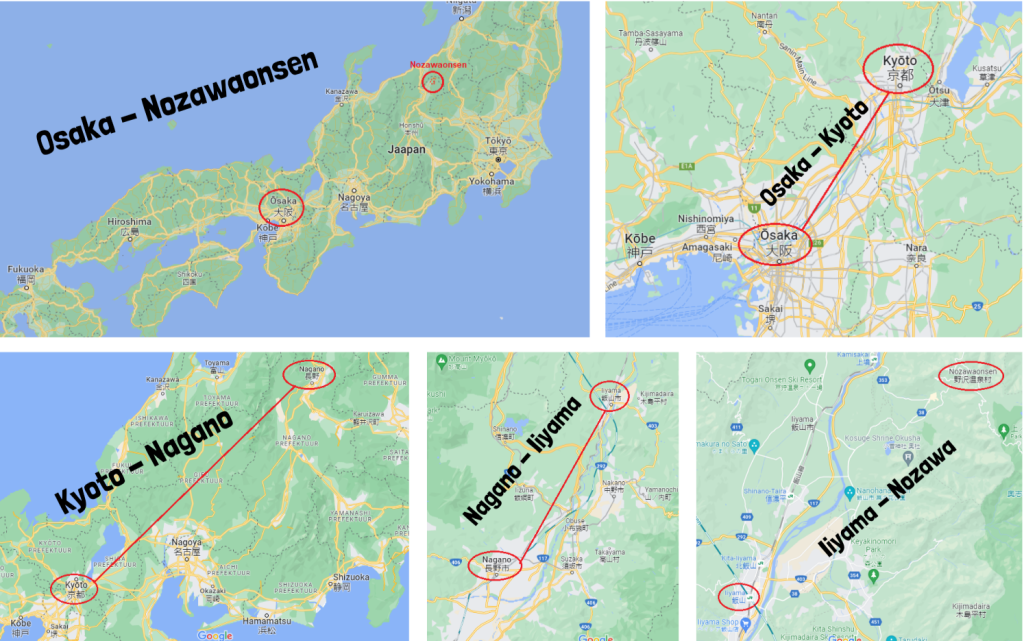
Osaka - just a brief moment from the bus window
With my four-hour sleep, I stepped again on a plane in Hong Kong. But... I was going to Japan! What did the lack of sleep matter?! I immediately remembered a well-known Estonian song about having all the time in the world to sleep in the winter. Taking some time at the expense of my sleep schedule, to explore a city to which I may never again return, sounded like a reasonable sacrifice.
After landing in Osaka I sat on the Kyoto bus without wasting a minute. My Nagano night bus was to depart from Kyoto and it was going to be a long journey, besides, I wanted to take the opportunity to see the former capital of Japan with my own eyes - it was literally on the way and not too far from Osaka. There simply weren't any flights to Kyoto - the famous city doesn't even have an airport! One of the first things I noticed was that there's not much use for English there - except for the airport attendants, I could only use some most basic English words here and there. Somehow, I still managed to buy the bus ticket. I did try to learn some Japanese with the Duolingo app before but didn't leave myself enough time for it.
The only few things I remember of Osaka at the time was what I saw from the bus window on my way to Kyoto. Whitish grey, almost identical apartment blocks. I had expected something completely different and was intently looking out of the window, searching to find a temple or an old traditional building but nothing, simply endless rows of those grey buildings. And then some weird.. practice fields?... surrounded by tall green net. Some sports courts? Baseball? Golf? I still don't know, although I vaguely remember asking about them. I have forgotten. Probably Quidditch. The flying one - that's how high the nets were.
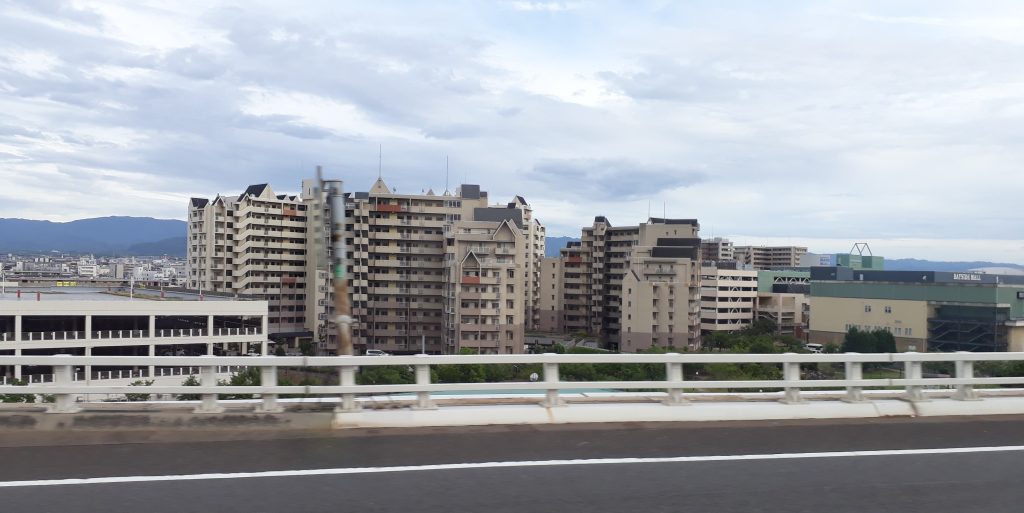
On board the bus, I noticed almost immediately a sign on the right had side of the interior, demanding absolute silence. Community and being considerate of others play a very important role in Japan - keeping quiet and not disturbing others are required and expected everywhere on public transport to spare the hardworking citizens from unnecessary noise. Japanese people work so incredibly much! I personally really appreciate this demand for silence, especially every time when I'm reminded of that horrible moment on one of Estonian domestic lines buses when a young man sitting in front of me started watching videos on his phone without headphones. With loud sound, of course. I'm not one to usually get up and say something but this time I couldn't be quiet, I asked him to use headphones. He of course protested that nobody is bothered by it but me, but thankfully a lady from opposite row said it bothers her too. So he had no choice. Estonians and Japanese are said to be quite alike, especially when it comes to the love of quiet but an Estonian is rarely saying anything, rather suffering in silence. I wonder how this situation would have gone down in Japan? Would he have been thrown off the bus? Pointing to the sign, waving hands or something? I might never know...
Four hour stopover in Kyoto
Reaching Kyoto station, my first goal was to find out where the night bus to Nagano departs from. All the rest could wait. It wasn't at all a simple task, however, because Kyoto station is huge! Seemingly endless corridors filled with restaurants and shops. As I only had about 4 hours (4 again?) and I was getting quite tired, I decided to stay in the station and explore everything it had to offer. I was completely fascinated! Japanese food... There was no equal to the visual display that now stared at me from shelves and countertops. Everything was so cute! Or, as the Japanese say - "kawaii!!" Colourful, animal shaped sweets made with excellent craftsmanship, large varieties of real mochi, sushi, ramen... It almost made one dizzy but instead of wearing out the excitement, only added to it with every new discovery.
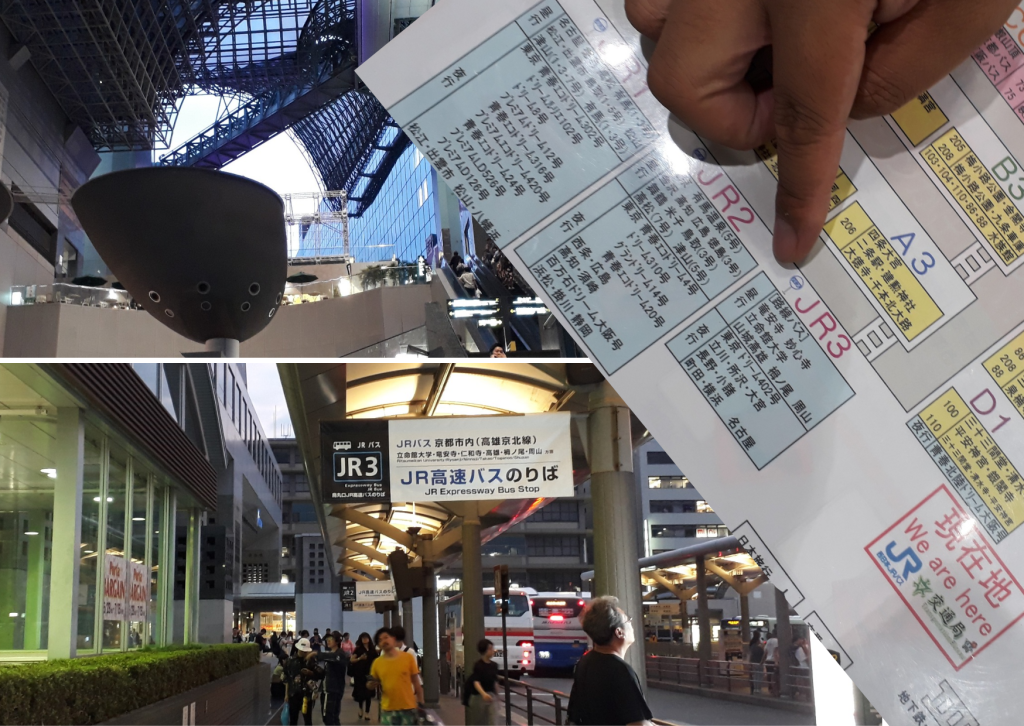
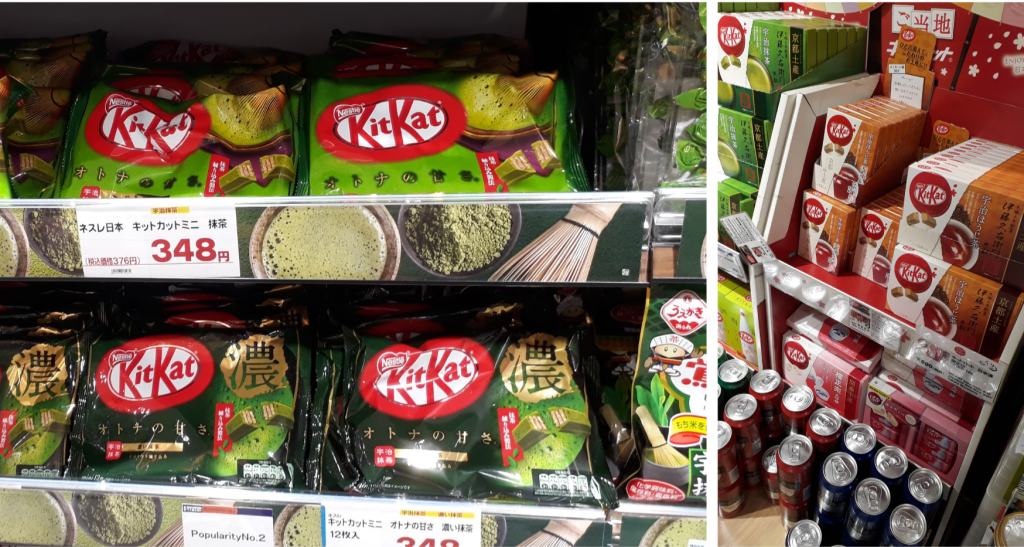
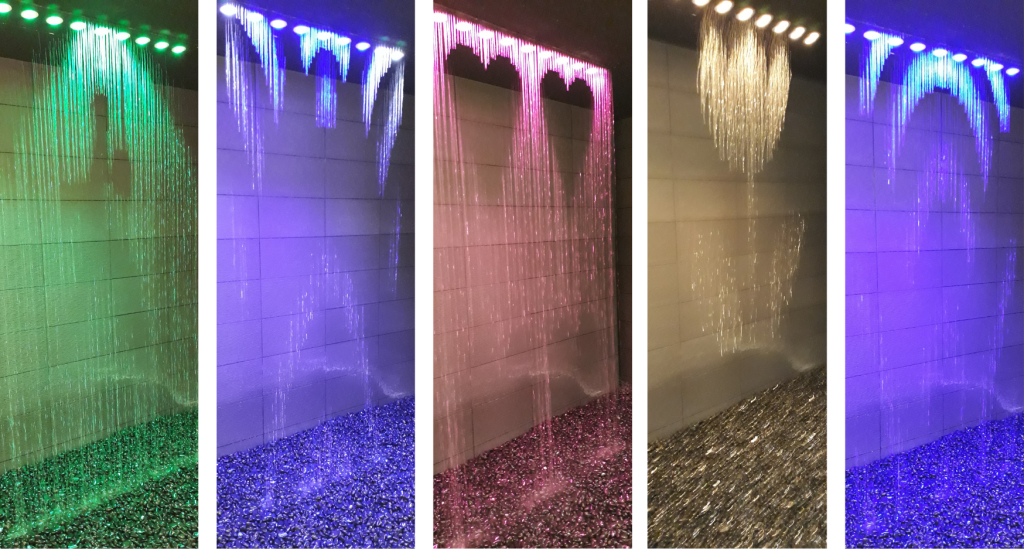
One of the very characteristic things about Japanese food culture are food replicas, or more commonly "fake food" ("shokuhin sampuru"in Japanese) instead of or accompanying a restaurant menu. On the display windows located on the outer walls of the restaurants were the most exact and realistic looking food replicas of the dishes offered in that restaurant - made from wax or now more often synthetic resins. They looked incredibly real! If you didn't know it was a replica, you'd bite down and break your teeth most likely! In some more creative versions you even saw a spoon (or rather chopsticks) hovering horisontally in the air above noodles, as if time has stopped mid-bite. Only, there was nobody holding the spoon... Only noodles, falling like a waterfall, frozen in time (or, wax).
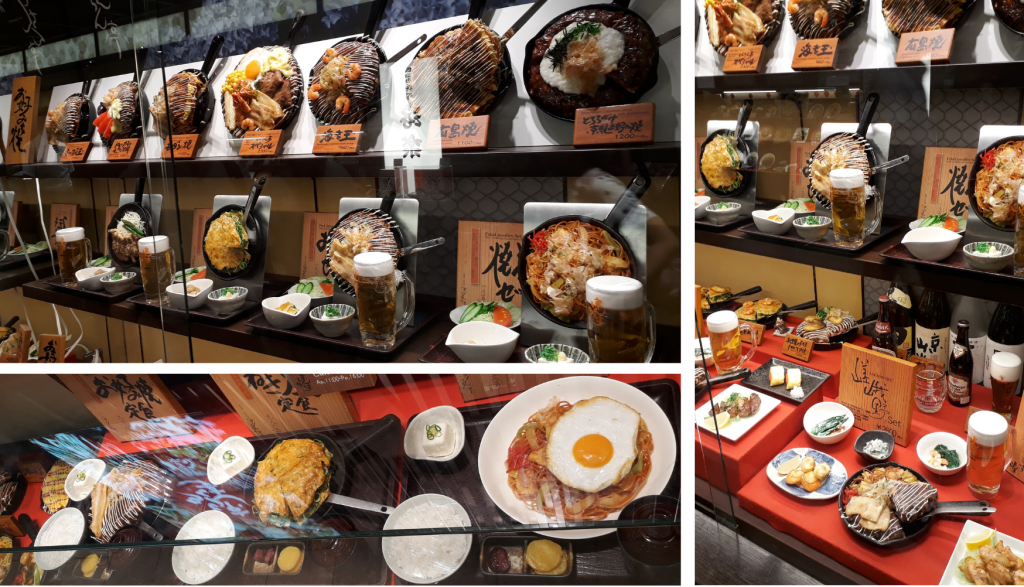
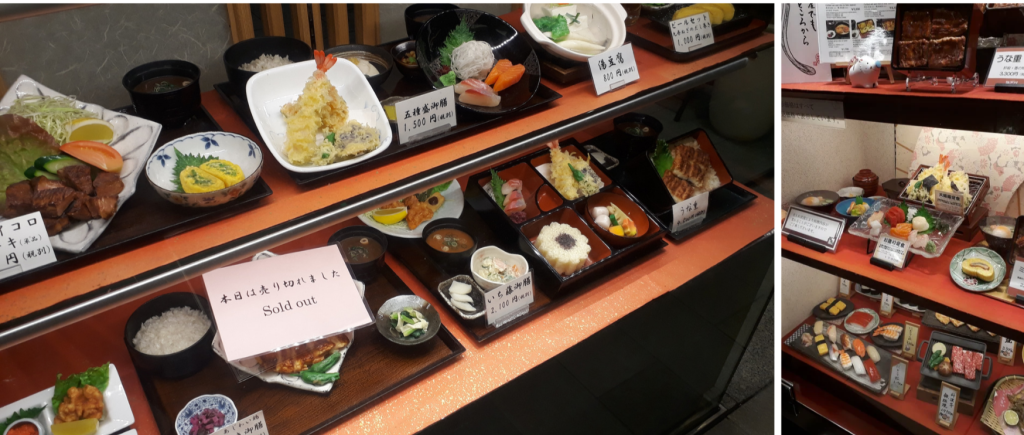
I marvelled and wondered. Any other way seemed impossible. I was also looking for something to eat, but how do you choose? I admit that I didn't dare enter any of the restaurants because I didn't know the language or customs, and was worried about putting myself in a stupid situation. What a silly fear when travelling! Being a foreigner, you are bound to do something wrong, absurd or even disastrous in the eyes of the locals, but this is how we learn also. Well, not this time. This time I chose a nice box of takeaway but still very real Japanese sushi - one of the few things that was much more expensive in Estonia. Takeaway ready-made foods were available everywhere in Japan, they were generally also very tasty and fresh. A lot of Japanese eat a lot of those just because they have no time to cook. The choice, therefore, is impressive and not at all expensive. The food is also delicious!
I took my sushi out and looked for a place to sit down and thoroughly enjoy my perfect looking nigiris. Eating while walking on the street is one of the "what-not-to-do-in-Japan" list's important items, although it is completely ok to sit down in a park and eat there. That's also why there aren't that many rubbish bins out in the street - Japanese just don't create rubbish outside. As an European, I was highly unaccustomed to this and were looking for a bin everywhere, however, I've never seen a cleaner country than Japan to this day. The people are most reasonable. Throwing trash on the ground is considered unacceptable and could be one of the reasons why they don't want foreigners and tourists around much.
Japanese sushi, even an already prepared take-away box is of course always fresh and of high quality. Beautifully presented, it also tasted divine.
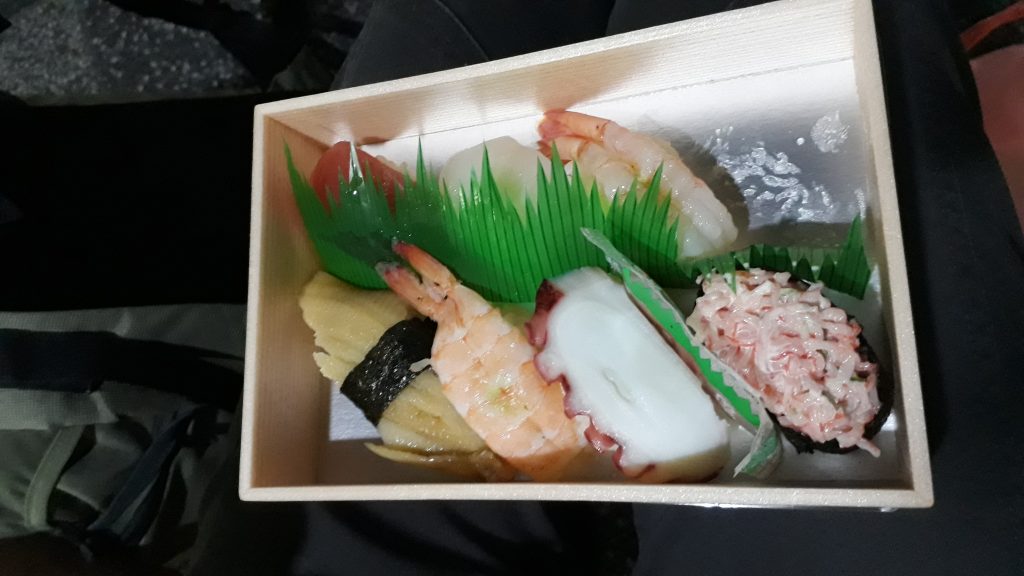
Another (and very much unexpected) thing that I found completely extraordinary - Japanese style toilets... I was speechless - a whole wall full of different buttons. Toilet seat with a heater. Button to play music out loud in case more privacy is needed for your nature calls - press to hear the sound of bird song and spring water. What else have they not thought about? Different bidet functions. Simply luxurious! And these are the normal public toilets, not some special orders made for villas and mansions. It would be amazing to have these hot seats in the cold Estonian winter, like sitting in a car! Sadly, only a week before (originally) writing about this I found out in a conversation with a Japanese person that it wouldn't work here - the water is too hard and full of limescale and it would block the system within days. And who is going to pour filtered water down the toilet? Of course, in Japan everything is clean drinking water...
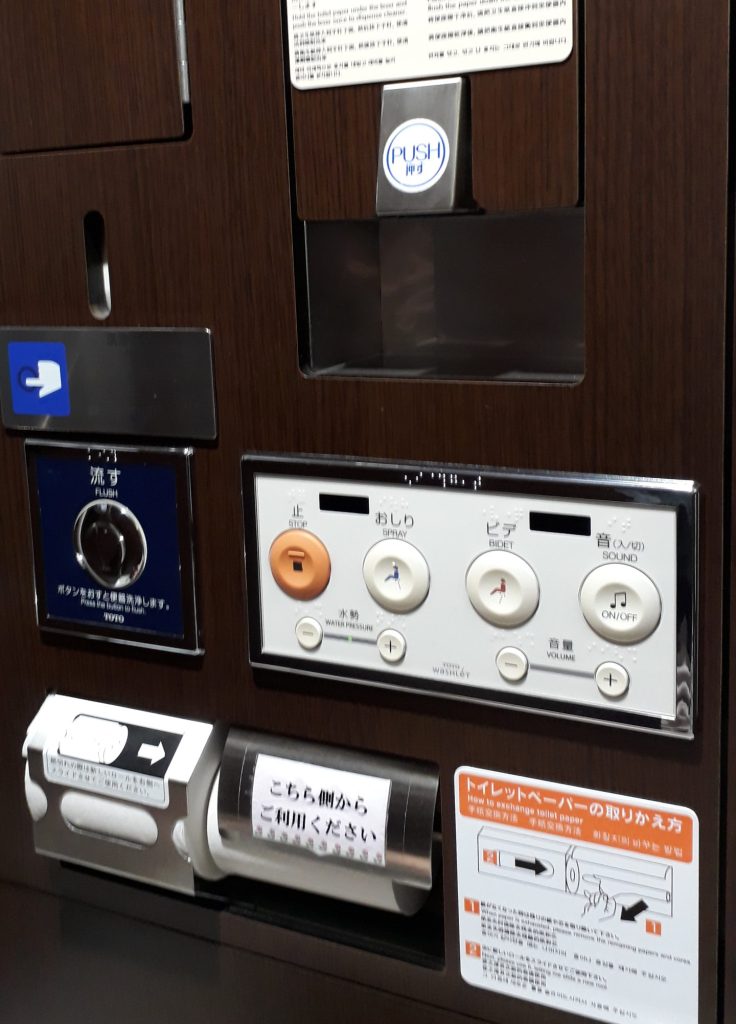
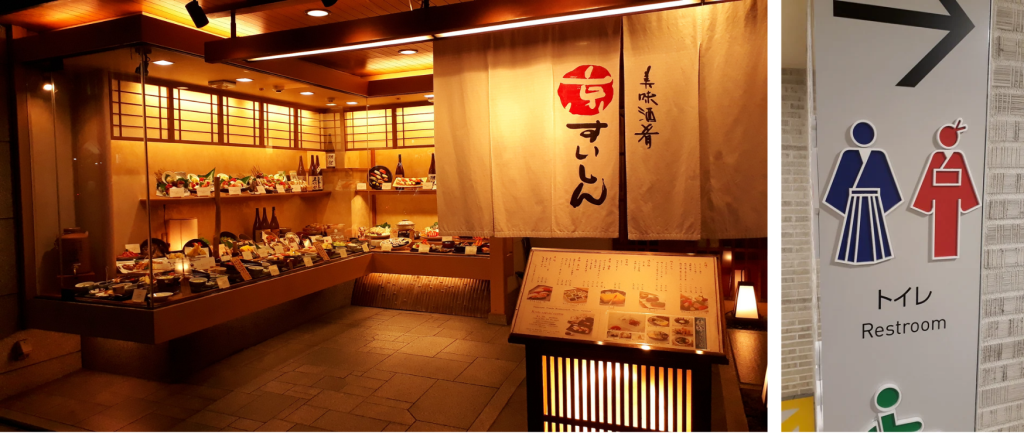
In the end, I did take a little walk around the block outside as well to see the surrounding streets and city life. It was already dark. For the first time I saw a Japanese style electronics shop which around the country were very popular also among tourists because local good quality products were sold much cheaper there than everywhere else in the world. And you could even get some of the taxes you paid returned to you when leaving the the country and declaring the purchased items (so, keep all your receipts!). Those shops, however, are enormous, 5 - 6 tightly packed floors. Yodobashi and Bic Camera are two of the main chains. I also noticed a great amount of vending machines, decorated with anime characters and other images and artwork associated with Japan. Toys, drinks, sweets, small electronics - there were vending machines for everything! And they were everywhere... I also saw a colourful fountain music show right next to the station entrance, with the Kyoto Tower (TV tower with a viewing platform) lit up at the back.
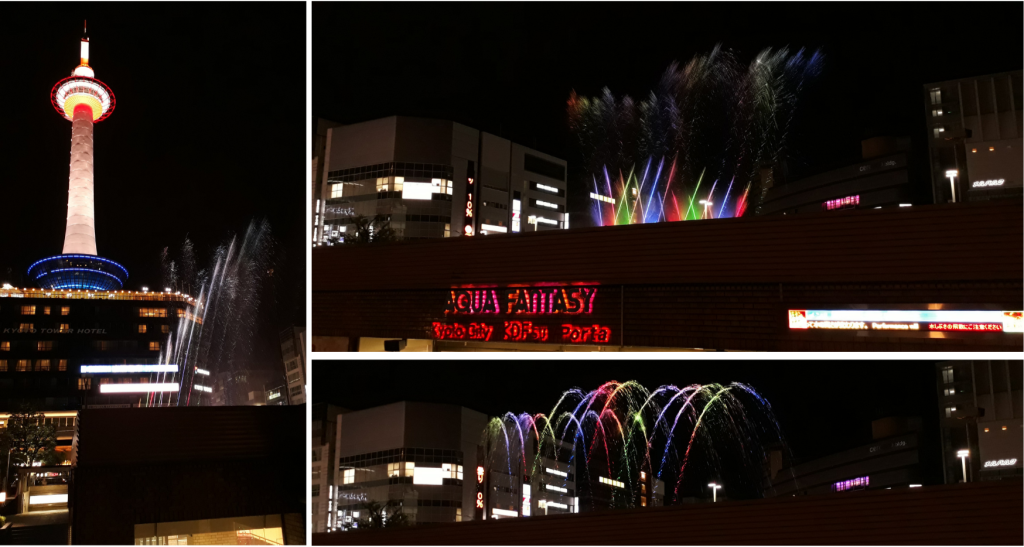
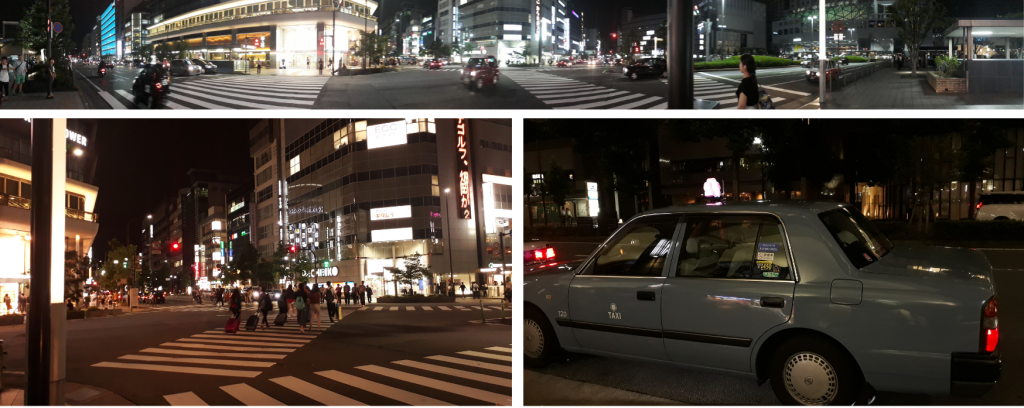
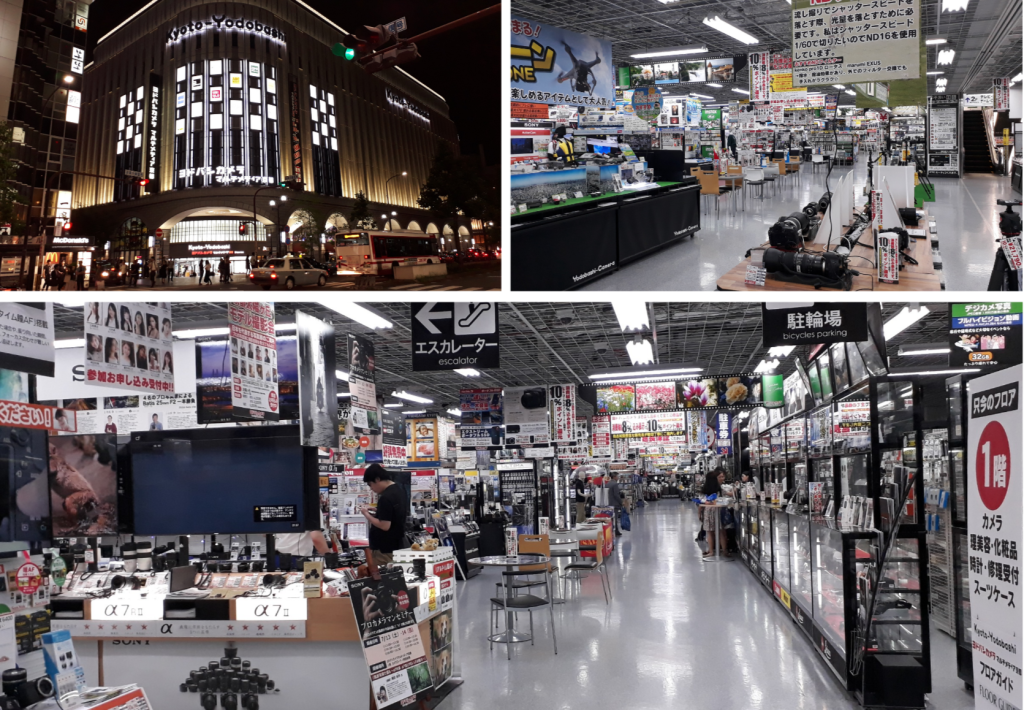
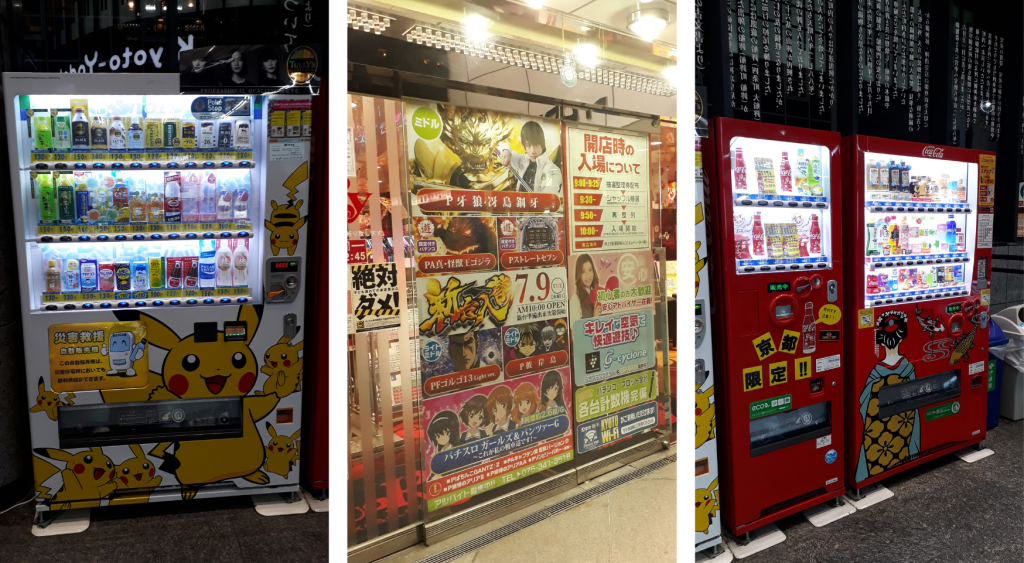
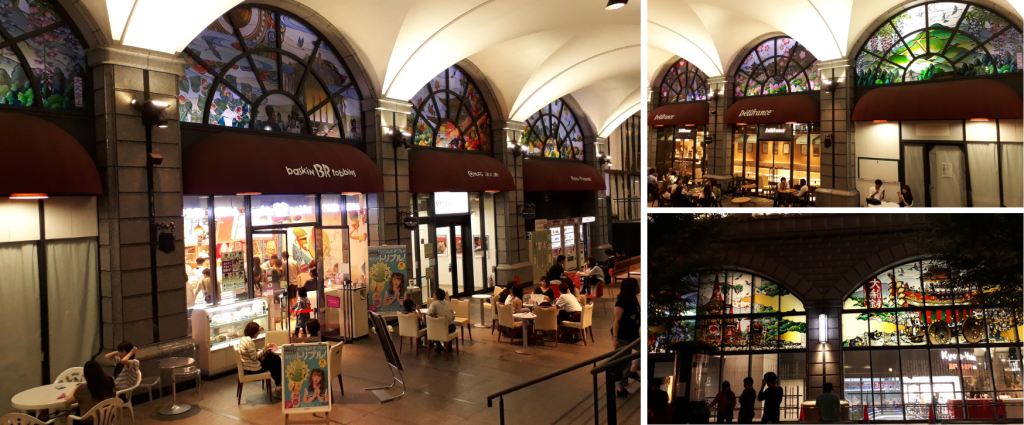
The only thing I remember I bought to take with me were mochi sheets, distinctive to Kyoto region. Mochi is a naturally sweet, spongy mass made of glutionous rice that has been pounded into a thick paste. Mochi is used mainly to make traditional sweets but is also used in savoury dishes. It is so good! One of the elements of Japanese cuisine I thought I never get enough of. The main thing that is made with mochi, and what is also often called mochi, is daifuku - a mochi ball, traditionally filled with sweet red bean paste. At first, the red bean paste tasted very bizarre and I couldn't understand why not just use chcolate or something, but I've gotten used to it by now and eat it happily. It is used a lot in Taiwanese cuisine also.

This was not going to be my last night bus but I must admit it's not easy to sleep in a chair. Yes, it was quiet, the sounds of the bus engine and wheels turning being the only ones you could hear, nobody else made a squeak. There would not have been much to see out the window even in the daylight because most of the journey passed along highways or inside tunnels (due to Japanese mountainous landscape). One unusual thing I just remembered from when I bought the bus ticket - women are sold special "women seats". Men absolutely are not allowed to sit on those seats. I could only guess it was because groping women in public by strangers (called "chikan" by Japanese) is a huge problem in Japan - especially in tight spots like packed up public transport where one does not even have room to turn around... And Japanese do not want to make a scene. I was lucky to never experience anything like this but I guess the ones doing it would not dare touch a foreigner - there is no way they're going to stay quiet just to avoid public embarassment.
There was one stop the bus made at a petrol station somewhere between mountains so we could stretch and walk around a little. Why I mention this - the air there was incredibly fresh! In the early hours of the crisp morning, far away from any kind of city pollution. Air that could be sold to China in a plastic bag...
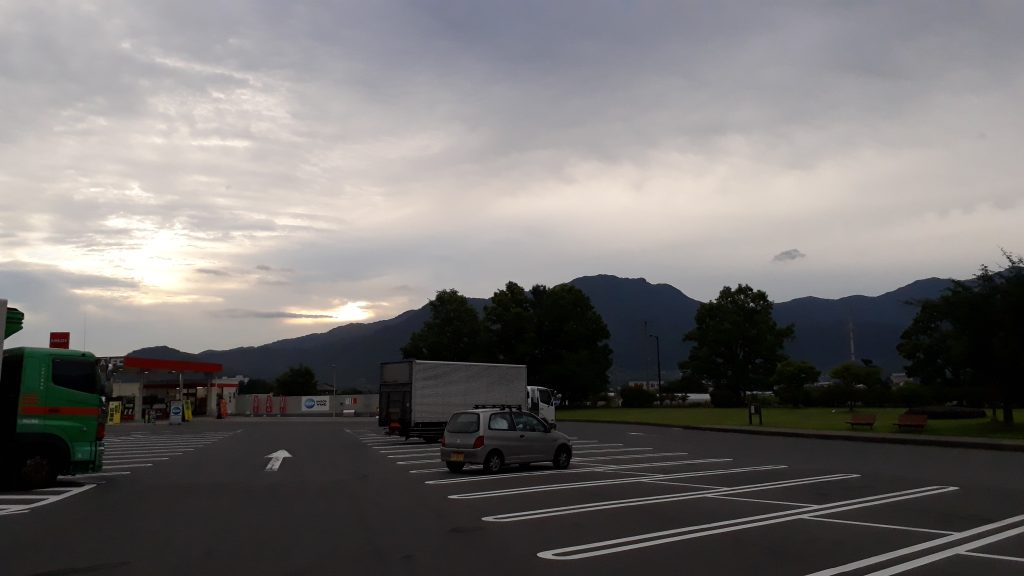
In Nagano, just as in Osaka, I only had a brief moment to spend - I still had to reach Iiyama and Nozawa from there. Nagano, once an Olympic capital, seemed small and quiet, however, it was still quite an early morning. When I arrived there, I had my breakfast sitting in another random location outside, this time the stone edge of a fountain with a beautiful statue of a goddess, while waiting for my Iiyama train. Another thing I now noticed in the daylight - the sewer hatches each had the name of the corresponding city/town written on them and they were decorated in accordance with the theme of that place. Nagano ones were the first I noticed but I saw many later on in various places, even outside Japan.
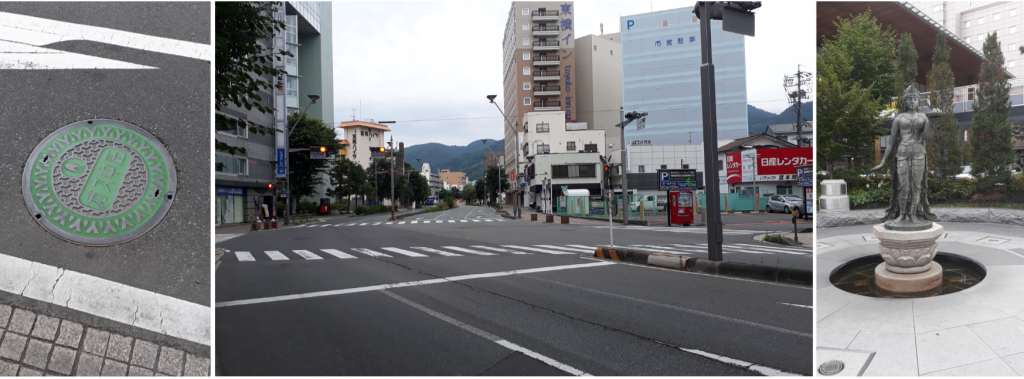
So, I took the train to Iiyama station from where I had instructions to find the local Nozawa bus. (Those familiar with world news - Iiyama was one of those areas that suffered a lot of damages due to flooding brought by the typhoon a few years back, the one that ravaged Tokyo.) There was a big supermarket in Iiyama - my first one in Japan. It was actually quite amusing to walk between the aisles there and look for anything that remotely looked familiar - everything was in Japanese and packed in unusual packages and bottles. I felt like I had walked into an alien store, I didn't understand anything! It was rare to find a product with English translation on it. It wasn't exactly a big city full of tourists and demands for English eihter. Fruits, (some) vegetables, pastry, milk, yoghurt... and of course whole shelves full of different types of rice were the only things I was able to recognize... The rest was all foreign to me and I had no idea what I was looking at. It was expected to find the most bizarre things among the seafood section but what created the most question marks in my confused head were some strange substances packed in liquid on the fruit and vegetable shelves. It honestly reminded me of the inside of some crazy scientist laboratory. Soy sauces I could only guess by the bottle and colour but there were about 50 different variations! I could do nothing but laugh at my helpessness - it seemed absurdly funny to me for some reason. Still, I managed to buy something - as food and cooking were the volunteer's own responsibility at that place. What made me incredibly happy though - I found the "kasutera" cake which I had once years back seen in an anime series, and it looked sooo delicious even cartoonishly drawn! I thought it had to be some special Japanese cake but boy was I wrong! It came out later that "kasutera" is a Japanese version of the Castella cake... In Japanese language, namely, consonant compounds are not used so all in case of foreign words adapted into Japanese, each consonant of a compound will get an extra vowel added after it. Also, because in Japanese "r" and "l" (latter is not used at all) are not distinguishable from each other (as is the case with "v" and "b", "Cas-tel-la" becomes "ka-s(u)-te-ra". I found it funny :) But the cake was amazing!
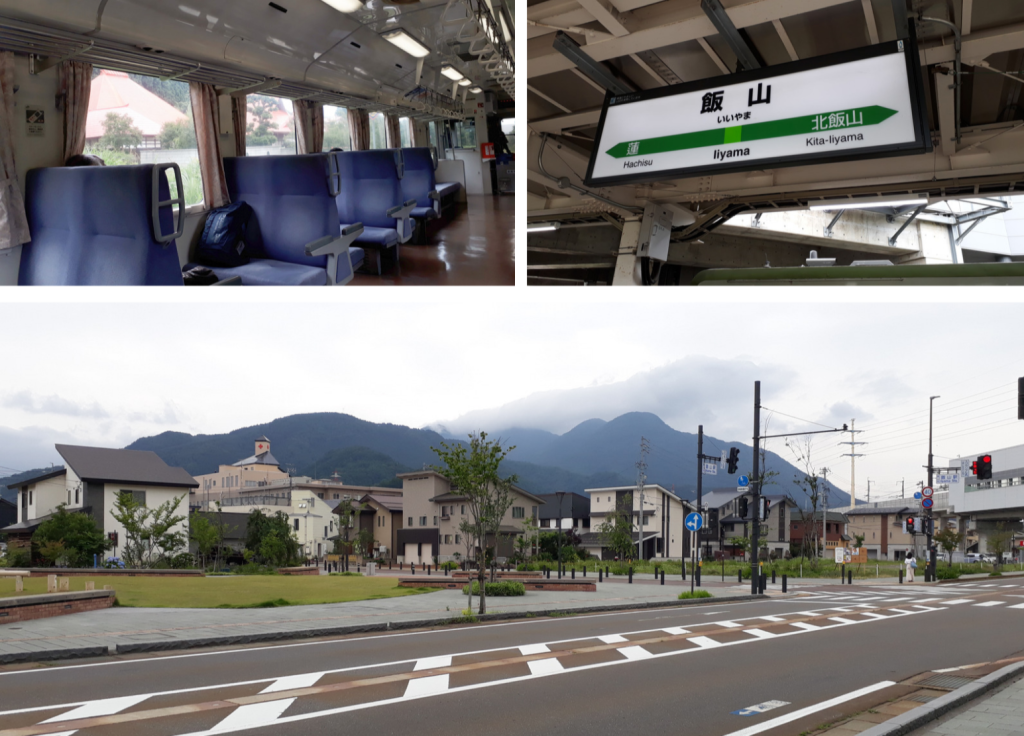
Keeping in touch via text with my new Australian "employer", it came out he and his Japanese wife were currently in Iiyama as well, so I didn't have to take the last bus - I met them at the supermarket car park and they took me to my new temporary home by car. Lucky!
The fairy tale village of Nozawa, however, is going to be in the next chapter.


